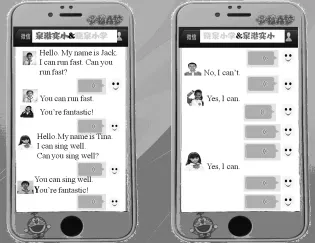《新标准英语》(三起)五(上)Module 6 Unit 1 You can play footballwell
林平珠 钟小婷
课例背景
本课例获得“第五届全国农村及少数民族地区中小学英语课堂教学观摩课”一等奖和最佳课件使用奖。本课教师主要运用情境创设法发展学生的语言运用能力。通过微信聊天和写表扬卡的方式,引导学生在自主学习英语的过程中运用已有的知识来解决问题,真正理解和运用知识,同时训练思维能力。
教学过程
Step 1.Warming up
课前欣赏:Enjoy a chant.
1.Greetings.
T:Hello,everyone.Are you ready for class?
S:Yes.
T:Let’s begin.Let’s say a chant.
2.Say a chant(如图 1).
3.Free talk.
T:Can you run?Can you swim?
S:...
T:Do you want to know something about me?You can ask me with“Can you...?”
S:...
设计意图:学生进入教室时开始播放Chant,让学生感知当天要复习的内容,同时能吸引学生的注意力,让学生感受学习氛围。通过say a chant、问候、自由交谈拉近了师生间的距离,同时再次复习和感知了句型“Can you...?Yes,I can./No,I can’t.”,为下文的学习做了很好的铺垫。
Step 2.Presentation
1.Lead in
(1)Show the title and learn“well”.
T:Look,I can swim,I can run fast and I can play football well.Can you?
S:Yes,I can.
T:You can play football well.(呈现完整课题)
设计意图:交谈中引出话题,明确了本节课的学习内容。同时在此处用拼读法学习新词well,通过读出旧单词bell,由旧知引向新知,并让学生能见形知音。
(2) Watchavideoand think:How to play footballer well?
T:Do you know how to play footballwell? Can you guess?
S:...
根据学生的回答及时板书(如图2)。

(图 2)
T:Let’s watch the video.
设计意图:通过讨论怎样踢好足球的头脑风暴,发散学生思维,复习以前学过的相关单词或词组。再观看自制足球短片,初步感知词汇和怎样踢好足球,为文本的学习做了铺垫。
(3)创设情境导入文本并学习单词team。
创设情境:Amy和Sam有一支足球队,然后简单介绍足球基础知识。Lingling想加入足球队,但是她能加入足球队吗?
T:Amy and Sam have a football team.Do you know how many people there are in a football team?
S:Eleven.
T:There are 11 people.They are strikers,midfielders,defenders and one goalkeeper.Look they are playing football now.Lingling wants to be in the football team.Can Lingling play football well?
设计意图:创设Lingling要加入Amy和Sam的足球队的情境,同时通过ea发[i:]的音让学生自己读出单词team,然后简单介绍足球队的人数与队员的基础知识。最后自然巧妙地导入文本,为文本学习设疑,引起学生的好奇心。
2.Learn Part 1
(1)Listen and answer.(听课文第一段并回答问题)
Q: Can Lingling play football well?
T: Can Lingling play football well?Let’s have a look.
(2)Check the answer and say the sentence“Can you...?”
T: Can Lingling play football well?
S:No,she can’t.
T:Why?
S:She can’t run fast.She can’t pass the ball well.
T:Let’s look and say(如图3).

(图 3)
(3) 总结:Lingling can’t play football well.
T:From the dialogue we know Lingling can’t run fast.Lingling can’tpass the ball well.So we don’t think Lingling can play football well.
设计意图:第一次接触文本第一段,学生带着任务听课文,为学生的听指明了方向。同时通过朗读文本——两个简单的对话,有助于学生理解文本,降低学习难度。最后通过总结得出结论 :Lingling can’t play football well.
3.Learn Part 2
(1) Read and answer.(阅读课文第二段并回答问题)
Q:WhydoesSam say“You can play footballwell,Lingling.”?
T:We dont’t think Lingling can play football well.But what does our friend Sam say?Let’s have a look.(播放课件 Sam:You can play football well,Lingling.)
T:Why does Sam say you can play football well,Lingling.Can you guess?
S:...
T:Let’s read and underline the answer.
(2)Check the answer and say“You can jump really high.You can catch the ball well”(如图 4).

(图 4)
用实物学习新单词catch。
(3)通过板书,总结Lingling的能力,通过对比推断出Lingling适合的位置:goalkeeper,然后进行单词教学。
T:We know Lingling can jump really high and Lingling can catch the ballwell.But Lingling can’trun fastand Lingling can’tpass the ball well. Which position can Lingling do well?Can Lingling be a striker?A midfielder?A defender or a goalkeeper.
T:So we think Lingling can be a goalkeeper(如图5).

(图 5)
设计意图:文本第一段得出结论:Lingling can’t play football well.但是文本中Sam却说:You can play football well,Lingling.通过这样强烈的信息差引起学生的注意,让他们产生解决问题的好奇心,通过自己阅读文本第二段的内容,画线找出为什么。通过对比Lingling的能力,最后得出结论:Lingling can be a goalkeeper.通过阅读画线,有助于学生理解文本。让学生自主学习,帮助他们掌握阅读的方法与技巧。
4.Learn Part 3
(1)学习 fantastic goalkeeper.
学生与教师一起推断出Lingling适合当守门员,通过比赛后Amy对Lingling的评价:Lingling, you’re a fantastic goalkeeper.学习新单词goalkeeper,fantastic。
T:So we think Lingling can be a goalkeeper.What about Sam and Amy?Let’s have a look.
(2)得出与Sam一样的结论:You can play football well(如图 6)。

(图 6)
设计意图:通过大家的推断再回归文本,进一步肯定大家的推断是正确的。通过Amy对Lingling的评价,做到在文本中教学新单词goalkeeper及fantastic,让学生清楚知道所学内容。通过最后总结得出结论:Lingling can play football well.从而完成课文的学习。
Step 3.Practice
1.Listen,point and imitate.
T:Let’s listen,point and imitate.Pay attention to your intonation and pronunciation.
设计意图:让学生开口通篇朗读,落实对文本的掌握,加深对课文内容的学习,提醒学生注意语音、语调,感受纯正的语音、语调,培养良好的语感。
2.Read in pairs
T:You can read well.Now let’s read in pairs and remember to help each other.
设计意图:给学生两分钟时间,通过与同桌一起互帮互助朗读课文,感受语言,体验语言内化的过程。鼓励学生通过互帮互助的形式一起朗读课文。
3.给动画配音
T:Boys and girls,let’s dub forthe text.Can you? Who wants to be Sam?Who wants to be Amy?And all of you are Lingling.Let’s go.
设计意图:通过自由选择喜爱的角色给动画配音,让学生感受语言、感受朗读语速,检验学生的学习情况,同时达到语言输出的目的。
Step 4.Production
1. We chat with my students
T:A message from my pupils.They want to be your friends.Let’s chat by We chat(如图 7).

(图 7)
设计意图:与时俱进,通过学生喜欢的微信聊天的形式复习当天的重点句型,达到在生活中运用语言的目的。同时鼓励学生多认识新朋友,引导学生将所学知识运用于生活中,达到学以致用的目的。
2.Write a praise card for your good friends (为你的好朋友点“赞”)
T:Now let’s write a praise card for your good friend.Like this...After the writing we can put it on the stage(如图 8).

(图 8)
设计意图:在听、说、读的基础上,让学生通过写表扬卡增进友谊,进一步落实到写的练习上,对所学新知进行梳理、巩固。用所学过的有关运动及其他表示能力的相关短语评价别人,使学生更好地认识和肯定别人。
3.Emotional education
T: Fantastic! You can praise your friendsverywell.Many people are worthy of praising.Let’s have a look (如图 9).Believe yourself!You’re fantastic!


(图 9)
设计意图:通过残疾人励志成才的图片及相关的文字信息,渗透情感,升华主题。同时培养学生发现自身优点,正确认识自己,增强自信心,促进自我发展。
Step 5.Homework
1.Listen and imitate 3 times.
2.Write a praise card to yourself.
设计意图:延伸课堂,让学生给自己写一张表扬卡,意识到自己的能力,做一个自信的人。同时这样能让学生在课后利用时间巩固和运用英语,达到学以致用的目的。
附:板书设计

(图 10)

